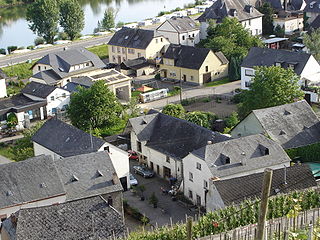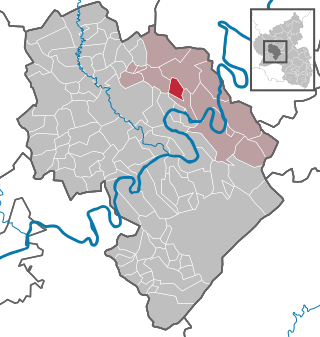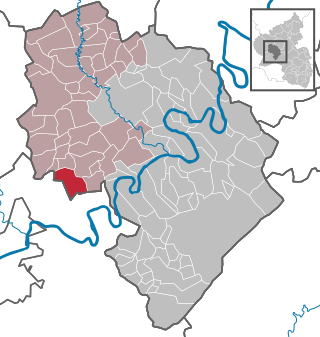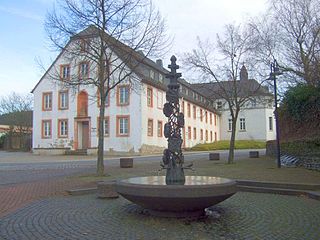
The Moselle is a river that rises in the Vosges mountains and flows through north-eastern France and Luxembourg to western Germany. It is a left bank tributary of the Rhine, which it joins at Koblenz. A small part of Belgium is in its basin as it includes the Sauer and the Our.

The Eifel is a low mountain range in western Germany, eastern Belgium and northern Luxembourg. It occupies parts of southwestern North Rhine-Westphalia, northwestern Rhineland-Palatinate and the southern area of the German-speaking Community of Belgium.

Klüsserath is a commune of the Verbandsgemeinde Schweich in the district Trier-Saarburg in Rhineland-Palatinate in Germany, on the river Moselle between Bernkastel-Kues and Trier.

Wittlich is a town in Rhineland-Palatinate, in western Germany, the seat of the Bernkastel-Wittlich district. Its historic town centre and the beauty of the surrounding countryside make the town a centre for tourism in southwest Germany.

Kinderbeuern is an Ortsgemeinde – a municipality belonging to a Verbandsgemeinde, a kind of collective municipality – in the Bernkastel-Wittlich district in Rhineland-Palatinate, Germany.

Hetzerath is an Ortsgemeinde – a municipality belonging to a Verbandsgemeinde, a kind of collective municipality – in the Bernkastel-Wittlich district in Rhineland-Palatinate, Germany.

Rivenich is an Ortsgemeinde – a municipality belonging to a Verbandsgemeinde, a kind of collective municipality – in the Bernkastel-Wittlich district in Rhineland-Palatinate, Germany.

Esch is an Ortsgemeinde – a municipality belonging to a Verbandsgemeinde, a kind of collective municipality – in the Bernkastel-Wittlich district in Rhineland-Palatinate, Germany.

Gladbach is an Ortsgemeinde – a municipality belonging to a Verbandsgemeinde, a kind of collective municipality – in the Bernkastel-Wittlich district in Rhineland-Palatinate, Germany.

Kinheim is an Ortsgemeinde – a municipality belonging to a Verbandsgemeinde, a kind of collective municipality – in the Bernkastel-Wittlich district in Rhineland-Palatinate, Germany.

Klausen is an Ortsgemeinde – a municipality belonging to a Verbandsgemeinde, a kind of collective municipality – in the Bernkastel-Wittlich district in Rhineland-Palatinate, Germany.

Platten is an Ortsgemeinde – a municipality belonging to a Verbandsgemeinde, a kind of collective municipality – in the Bernkastel-Wittlich district in Rhineland-Palatinate, Germany.

Schweich an der Römischen Weinstraße is a Verbandsgemeinde in the Trier-Saarburg district, in Rhineland-Palatinate, Germany.

The Battle of Clausen was fought on 20 October 1735 near the town of Klausen, which was then in the Electorate of Trier and part of the Holy Roman Empire, and is now in the German state of Rhineland-Palatinate. French forces under the command of Marshal François de Franquetot de Coigny were defeated in an attempt to dislodge imperial troops under the command of Friedrich Heinrich von Seckendorff. The battle was one of the last significant engagements between the combatants in the War of the Polish Succession.

The Koblenz–Trier Railway is a railway line in the German state of Rhineland-Palatinate, located mostly on the left (northern) bank of the Moselle, connecting Koblenz via Bullay to Trier. It is known in German as the Moselstrecke, i.e. "Moselle line". It is often called the Moselbahn links der Mosel to distinguish it from the Moselle Railway (Moselbahn) or Moselle Valley Railway (Moseltalbahn), which ran on the right (southern) bank of the Moselle from Bullay to Trier, but was abandoned in the 1960s. The line was built as part of the Cannons Railway (Kanonenbahn) and opened in 1879.

Wittlich Hauptbahnhof is a railway station for the town of Wittlich in the German state of Rhineland-Palatinate and is on the Koblenz–Trier line. Until the closure of the Wengerohr–Daun and Wengerohr–Bernkastel-Kues lines, it was a junction station and a regional rail node. Today it is the only station in Wittlich.
The Moselle Hills form a ridge, up to 434.1 m above sea level (NHN), on the left bank of the river Moselle between Reil and Schweich in the Rhineland-Palatinate counties of Bernkastel-Wittlich and Trier-Saarburg. There are vineyards on the southern slopes of the wooded hills. They lie on the southern edge of the Eifel region.
The Kellerberg is a hill, 448.8 m above sea level (NHN), and the highest point of the Eifel part of the Meulenwald and of the collective municipality of Wittlich-Land. It rises near Dierscheid in the county of Bernkastel-Wittlich in the German state of Rhineland-Palatinate. At the top is the Kellerberg Observation Tower.

Windsborn Crater Lake is a water-filled volcanic crater in the Eifel mountains in Germany. It is located near Bettenfeld in the county of Bernkastel-Wittlich and in the state of Rhineland-Palatinate, and belongs to a group of four craters known as the Mosenberg Crater Row, named after the village of Mosenberg.
The Meulenwald, also called the Mühlenwald, is a bunter sandstone hill ridge, up to 448.8 m above sea level (NHN), in the southern part of the Eifel mountains in the counties of Trier-Saarburg and Bernkastel-Wittlich in the German state of Rhineland-Palatinate.

















